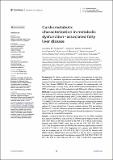Por favor, use este identificador para citar o enlazar a este item:
http://hdl.handle.net/10261/304037COMPARTIR / EXPORTAR:
 SHARE SHARE
 CORE
BASE CORE
BASE
|
|
| Visualizar otros formatos: MARC | Dublin Core | RDF | ORE | MODS | METS | DIDL | DATACITE | |

| Título: | Cardiometabolic characterization in metabolic dysfunction-associated fatty liver disease |
Autor: | Perdomo, Carolina M.; Núñez-Córdoba, J.M.; Ezponda, Ana; Mendoza, Francisco J.; Ampuero, Javier CSIC ORCID; Bastarrika, Gorka; Frühbeck, Gema; Escalada-San Martín, Javier | Palabras clave: | Visceral adipose tissue Coronary artery calcium Epicardial adipose tissue Metabolic dysfunction-associated fatty liver disease Nonalcoholic fatty liver disease |
Fecha de publicación: | 20-oct-2022 | Editor: | Frontiers Media | Citación: | Frontiers in Medicine 9: 1023583 (2022) | Resumen: | [Background] To better understand the patient's heterogeneity in fatty liver disease (FLD), metabolic dysfunction–associated fatty liver disease (MAFLD) was proposed by international experts as a new nomenclature for nonalcoholic fatty liver disease (NAFLD). We aimed to evaluate the cardiovascular risk, assessed through coronary artery calcium (CAC) and epicardial adipose tissue (EAT), of patients without FLD and patients with FLD and its different subtypes. [Methods] Cross sectional study of 370 patients. Patients with FLD were divided into 4 groups: FLD without metabolic dysfunction (non-MD FLD), MAFLD and the presence of overweight/obesity (MAFLD-OW), MAFLD and the presence of two metabolic abnormalities (MAFLD-MD) and MAFLD and the presence of T2D (MAFLD-T2D). MAFLD-OW included two subgroups: metabolically healthy obesity (MHO) and metabolically unhealthy obesity (MUHO). The patients without FLD were divided into 2 groups: patients without FLD and without MD (non-FLD nor MD; reference group) and patients without FLD but with MD (non-FLD with MD). EAT and CAC (measured through the Agatston Score) were determined by computed tomography. [Results] Compared with the reference group (non-FLD nor MD), regarding EAT, patients with MAFLD-T2D and MAFLD-MUHO had the highest risk for CVD (OR 15.87, 95% CI 4.26-59.12 and OR 17.60, 95% CI 6.71-46.20, respectively), patients with MAFLD-MHO were also at risk for CVD (OR 3.62, 95% CI 1.83-7.16), and patients with non-MD FLD did not have a significantly increased risk (OR 1.77; 95% CI 0.67-4.73). Regarding CAC, patients with MAFLD-T2D had an increased risk for CVD (OR 6.56, 95% CI 2.18-19.76). Patients with MAFLD-MUHO, MAFLD-MHO and non-MD FLD did not have a significantly increased risk compared with the reference group (OR 2.54, 95% CI 0.90-7.13; OR 1.84, 95% CI 0.67-5.00 and OR 2.11, 95% CI 0.46-9.74, respectively). [Conclusion] MAFLD–T2D and MAFLD–OW phenotypes had a significant risk for CVD. MAFLD new criteria reinforced the importance of identifying metabolic phenotypes in populations as it may help to identify patients with higher CVD risk and offer a personalized therapeutic management in a primary prevention setting. |
Versión del editor: | https://doi.org/10.3389/fmed.2022.1023583 | URI: | http://hdl.handle.net/10261/304037 | DOI: | 10.3389/fmed.2022.1023583 | ISSN: | 2296-858X |
| Aparece en las colecciones: | (IBIS) Artículos |
Ficheros en este ítem:
| Fichero | Descripción | Tamaño | Formato | |
|---|---|---|---|---|
| fatty-liver-disease.pdf | 958,37 kB | Adobe PDF |  Visualizar/Abrir |
CORE Recommender
PubMed Central
Citations
3
checked on 13-abr-2024
SCOPUSTM
Citations
3
checked on 17-abr-2024
WEB OF SCIENCETM
Citations
3
checked on 22-feb-2024
Page view(s)
29
checked on 18-abr-2024
Download(s)
15
checked on 18-abr-2024

